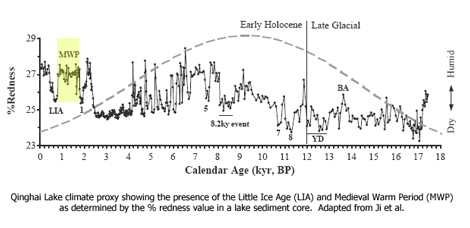Reference
Ji, J., Shen, J., Balsam, W., Chen, J., Liu, L. and Liu, X. 2005. Asian monsoon oscillations in the northeastern Qinghai-Tibet Plateau since the late glacial as interpreted from visible reflectance of Qinghai Lake sediments. Earth and Planetary Science Letters 233: 61-70.
Description
Reflectance spectroscopy was applied to a sediment core taken from the southeastern basin of Qinghai Lake, China (36°32' to 37°15'N, 99°36' to 100°47'E). Sediment redness, which is related to iron oxide content, was judged to be an indicator of paleoclimatic changes in the core. Lower redness values were found to generally correlate with light, laminated sediments "associated with cold periods including the Little Ice Age (LIA)," whereas "warm periods, e.g., Medieval Warm Period (MWP), ... were marked by the accumulation of reddish-colored sediments." Based upon these findings we can judge the MWP to have been a long warm and wet period (AD 400-1200, the MWP) sandwiched between the cold and dry spells of the Dark Ages Cold Period (100 BC-200 AD) and Little Ice Age (AD 1220-1600).





